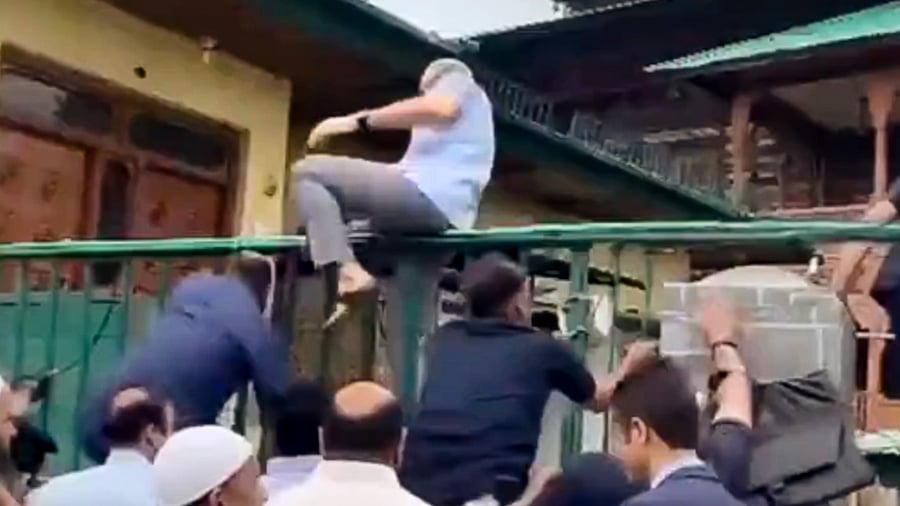
This screengrab shows Jammu and Kashmir Chief Minister Omar Abdullah climbing a fence to pay tribute to July 13 martyrs at Naqshband Sahib graveyard in the Old City of Srinagar, Monday, July 14, 2025.
Credit: PTI Photo
Srinagar: A dramatic act of defiance by Chief Minister Omar Abdullah at the Khwaja Naqshband Sahib shrine in Srinagar’s old city earlier this week has crystallized what observers have long warned: Jammu and Kashmir is hurtling toward a full-blown crisis of dual authority.
In widely circulated images, Abdullah is seen climbing the iron fence of the historic shrine, after being denied access by security personnel. His aim was to pay homage at the graves of 22 Kashmiri Muslims gunned down by Dogra forces in 1931—a politically symbolic ritual that successive heads of government in J&K had undertaken for decades till 2019 when J&K’s special status under Article 370 was revoked.
This time, however, the elected Chief Minister was physically stopped by the police on the directions of the L-G administration.
The standoff was not merely symbolic. It revealed the deeper contradiction at the heart of Jammu and Kashmir’s post-Article 370 political architecture: an elected government that rules, and a Lieutenant Governor who governs.
“We suffered in silence for the past eight months but did not complain,” Omar said shortly after the incident.
“But don’t misconstrue our decency for weakness. We don’t talk loudly, threaten or resort to gundagardi (hooliganism) but that does not mean we are weak,” he warned.
The incident followed an earlier confrontation in April 2025, when L-G Sinha unilaterally issued transfer orders for several JKAS officers—civil servants traditionally under the administrative purview of the Chief Minister. The orders sparked political uproar, with Abdullah calling an emergency cabinet meeting and accusing the L-G of undermining constitutional norms.
“The transfer order was not just about reshuffling officials,” said a senior NC leader. “It was a signal that the Raj Bhavan continues to act as the de facto government, despite the return of an elected assembly. That’s unacceptable.”
The power struggle highlights a deeper structural contradiction in post-Article 370 Jammu and Kashmir. While the Union Territory now has an elected assembly, real executive power continues to be concentrated in the hands of the Lieutenant Governor, who answers directly to New Delhi.
“This was inevitable,” political analyst Prof Gul Mohammad Wani told DH. “You cannot run a democracy where an elected Chief Minister plays second fiddle to an unelected official. Monday’s act of defiance was as much about symbolism as it was about reclaiming authority.”
The shrine standoff has since escalated into a political flashpoint, with national opposition leaders jumping into the fray. Congress President Mallikarjun Kharge and Rahul Gandhi wrote to Prime Minister Narendra Modi urging the Centre to introduce legislation to restore full statehood in the current Monsoon Session of Parliament.
On the ground in Kashmir, the NC-led government has been walking a tightrope. While wary of confronting New Delhi head-on, it has faced mounting pressure to assert autonomy in the face of what critics call “bureaucratic overreach.” The L-G’s office, meanwhile, maintains that its actions are within the constitutional framework of a Union Territory.
Abdullah’s protest comes as frustration builds within the Valley over the NC-led government’s perceived passivity in challenging the L-G administration’s dominance. In recent days, the Chief Minister has sharpened his rhetoric, questioning the L-G’s failure to prevent the Pahalgam terror attack, and raising concerns over the utilization of funds under the Srinagar Smart City project.
What happens next could shape the future of Kashmir’s political structure. With calls for the restoration of statehood getting louder and the NC signaling it will no longer play a passive role, the fragile balance between Delhi’s oversight and Srinagar’s aspirations is tilting.